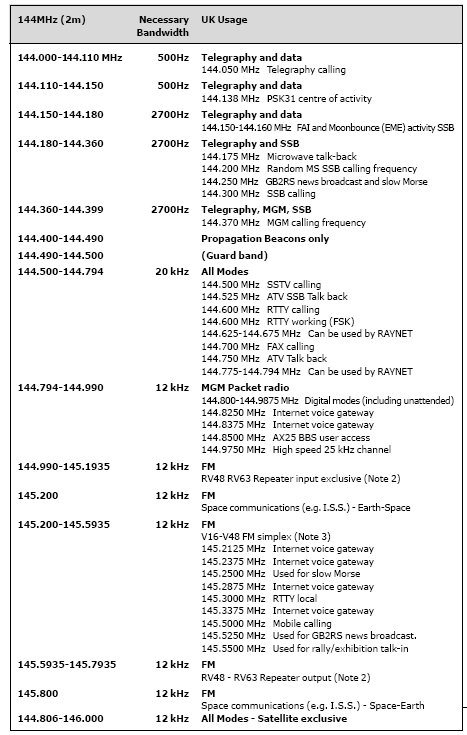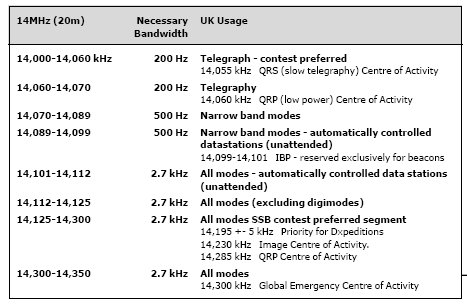



Section 7
Operating practices and procedures
Band plans
7B1 Recall why band plans are used.
Some important frequencies in the 144MHz Band Plan

Some important frequencies in the 14MHz Band Plan

Many students, in the past, have not given nearly enough attention to the detail of the Band plans and loose easy marks. Please make sure that you know how the band plan works and what is the meaning of the information contained there in.
The band plan for 14MHz shows you a lot of information that fortunately you do not have to learn but you must have a full understanding.
The first column shows you where in the band the preferred modes should be operated. Note particularly the section on Beacons as operating in that section is a definite no no as it is reserved exclusively for a set of beacons located around the world that are linked to the atomic time signals so that they give their CW ident at the same time every time and do not overlap each other.
The centre columns indicates the Max Bandwidth and UK mode usage
The right hand column goes into more details as to what operating can be done where.
The band plan for 14MHz will be available to you in the written assessment.
The band plan for 144MHz is possible even more complex than that for the 14MHz band and certainly has a great deal of detail.
So to remind you again :-
Please ensure that you obtain a paper copy so that you can look through the chart carefully.
Be aware of what it contains and then you will be ready for any questions relating to the chart and then you can just look up the answer.
You could have a question that relates to anything shown on the Band plan.
Too many students are losing marks it is assumed that because this paper work will be with you in the exam that they do not bother to look at it in detail
Identify items on a typical band plan (e.g. calling frequencies and recommended modes).
The Band Plan is a document that lays out the various modes and operating frequencies within that legal allocation. The Band Plan is operated voluntarily, but should be adhered to. It's purpose is to ensure the most effective use of the limited radio spectrum that we have available to us.
The schedule and band plan will be provided to you during the written examination and the practical assessment, so there is no need to learn it, however you must show that you can understand and extract information from it.
Some important frequencies in the 144MHz Band Plan
144.300 MHz SSB calling - this is the frequency that all station call initially on SSB and then QSY unless it is a contest when you will hear stations calling additionally on other parts of the band.
144.600 MHz RTTY calling frequency with the working frequencies either side of this centre frequency.
145.500 MHz FM (mobile) calling - in fact this frequency is used by all operators as a calling frequency whether mobile or fixed.
145.525 MHZ RSGB News frequency ON SUNDAYS ONLY so best keep clear !!
145.550 MHZ Rally and Exhibition "Talkin" Frequencies.
Recall that narrow band modes are at the lower end of most bands.
If you take a look at the bands plans and preferable print out a copy so you can have a good look and thus a "WORKING KNOWLEDGE" OF THE PLANS you will notice narrow band modes are at the lower end of most bands.
Recall that lower sideband operation normally occurs below 10MHz and uppersideband above 10MHz.
The convention used by many radio amateurs is that on SSB lower sideband operation normally occurs below 10MHz and upper sideband used above 10MHz.
Recall that transmissions on beacon frequencies must be avoided.
14.099 to 14.101MHz BEACONS ONLY
The beacons are there to help you determine what the propagation is like around the world so you must keep clear of those frequencies.
Note:
For the purposes of the examination narrow modes are CW and data.
A copy of the
relevant band plans will be available during the examination but may not be ones in
current use.
Reference Booklets containing examination band plans are available on the RSGB web site.
7B2 Recall that frequency bands are allocated for particular use, e.g. broadcasting, aeronautical, maritime and amateur.
Recall the frequency bands for HF, VHF, and UHF radio signals.
Recall that some amateur bands are shared with or adjacent to other spectrum users.
Identify items on a provided chart of spectrum users
The origin of some of the text on this page is from the RSGB with additions by the web master